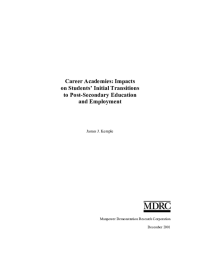Career Academies: Impacts on Transitions to Postsecondary Education and Employment
Established more than 30 years ago, Career Academies have spread rapidly over the past decade as states, school districts, and individual schools throughout the country have turned to the approach as part of a solution to a range of problems faced by large comprehensive high schools. Career Academies are typically characterized by three basic features: a school-within-a-school organizational structure, curricula that combine academic and career or technical courses based on a career theme, and partnerships with local employers. The main goals of Academies are to prevent students from dropping out and to prepare them for college and careers.
In 1993, MDRC began conducting the Career Academies Evaluation, a 10-year longitudinal study of the Academy model in nine schools around the country. In the evaluation, more than 1,700 Academy applicants in the 8th or 9th grade were randomly assigned to enroll in their high school's Academy (the Academy group) or to enroll in any other high school program (the non-Academy group). The differences between the two groups' outcomes serve as estimates of the Academies' effects. Owing to its random assignment design, diverse set of participating students and sites, and long follow-up period - which extends four years beyond the students' scheduled graduation from high school - this study is both more comprehensive and more rigorous than previous studies of Academies and other school reforms. The evaluation is being funded by the U.S. Departments of Education and Labor and 17 private foundations and organizations. The new impact findings presented in this report are based on survey data collected about one year after scheduled high school graduation. A later report will present results for the rest of the follow-up period.
Key Findings
Although the participating Career Academies enhanced the high school experiences of their students in ways that are consistent with the reform's short-term goals, these positive effects did not translate into changes in high school graduation rates or initial transitions to post-secondary education and jobs.
- Earlier results from the evaluation indicate that the Academies improved students' high school experiences on several fronts, including their average level of school engagement, the rate at which they combined academic and career-related courses, and the rate at which they participated in career awareness and work-related learning activities. The Academies had little influence, however, on course content and classroom instructional practices and left standardized test scores unchanged.
- For students who entered the programs at high risk of dropping out, the Academies increased the likelihood of staying in school through the end of the 12th-grade year, improved attendance, and increased the number of credits earned toward graduation.
- The results presented in this report show that, relative to similar students nationally, both the Academy and the non-Academy groups had high rates of high school graduation, college enrollment, and employment.
- The Academies had little or no impact on high school graduation rates and initial post-secondary education and employment outcomes. In other words, the Academy group's relatively high outcome levels were matched by those of the non-Academy group - the best benchmark against which to compare the Academy group's performance. This was true for subgroups of students at high, medium, and low dropout risk.
- The results suggest that Career Academies should consider expanding their efforts to recruit students who may not be motivated to enroll in Academies on their own, to provide college counseling from the beginning of high school, and to ensure that teachers have access to professional development opportunities aimed at improving curriculum and instruction.
The new findings go beyond those presented in earlier reports from this evaluation and from previous research on Career Academies. Nevertheless, the full story of Academies' effectiveness is still unfolding. Data collected as the evaluation continues will shed light on any differences between the Academy and non-Academy groups' education and labor market experiences that emerge during the second, third, and fourth years after high school.






